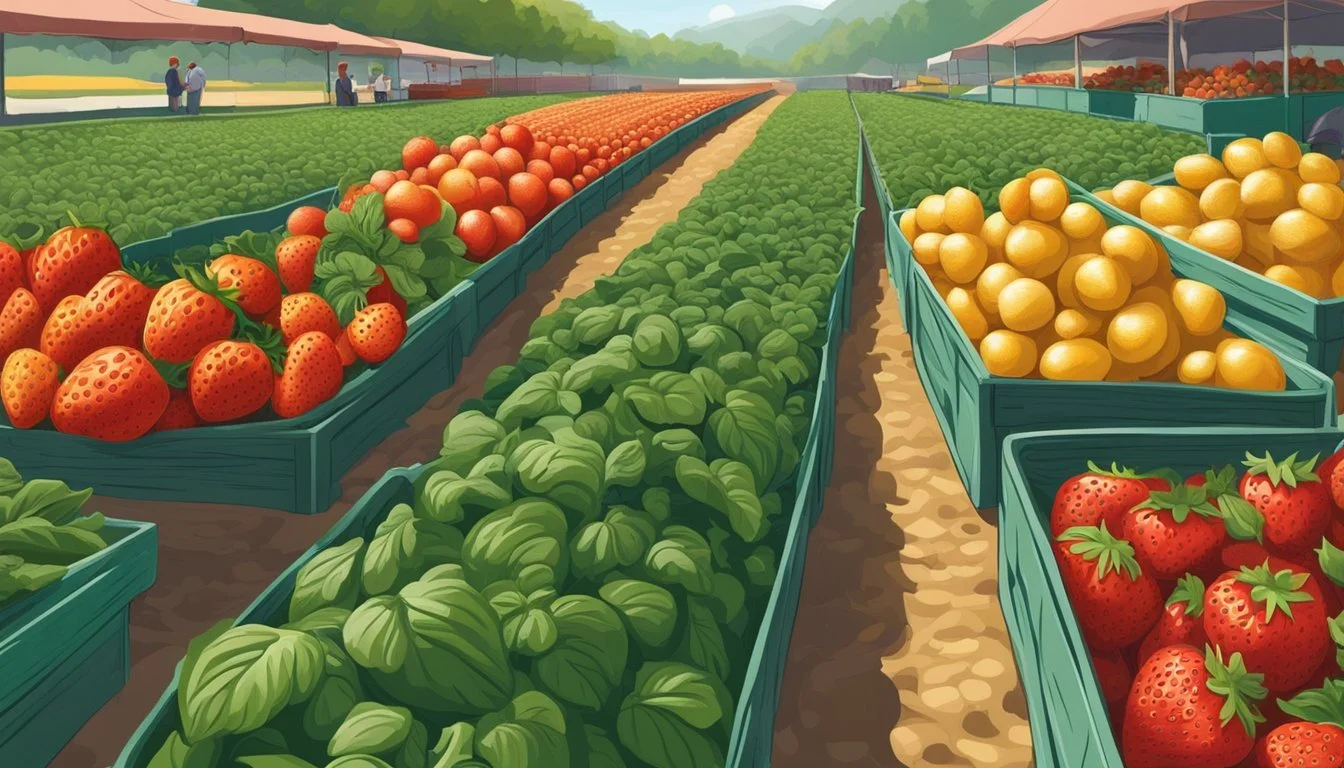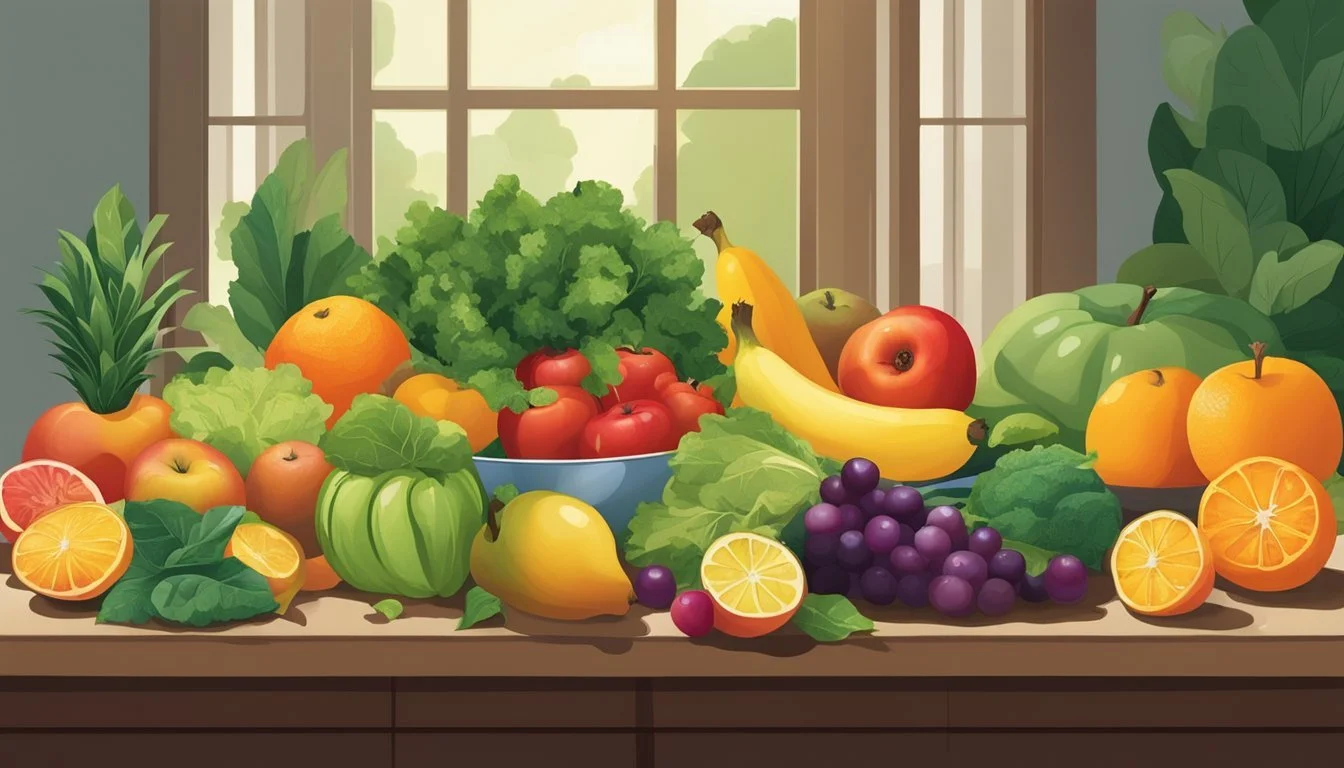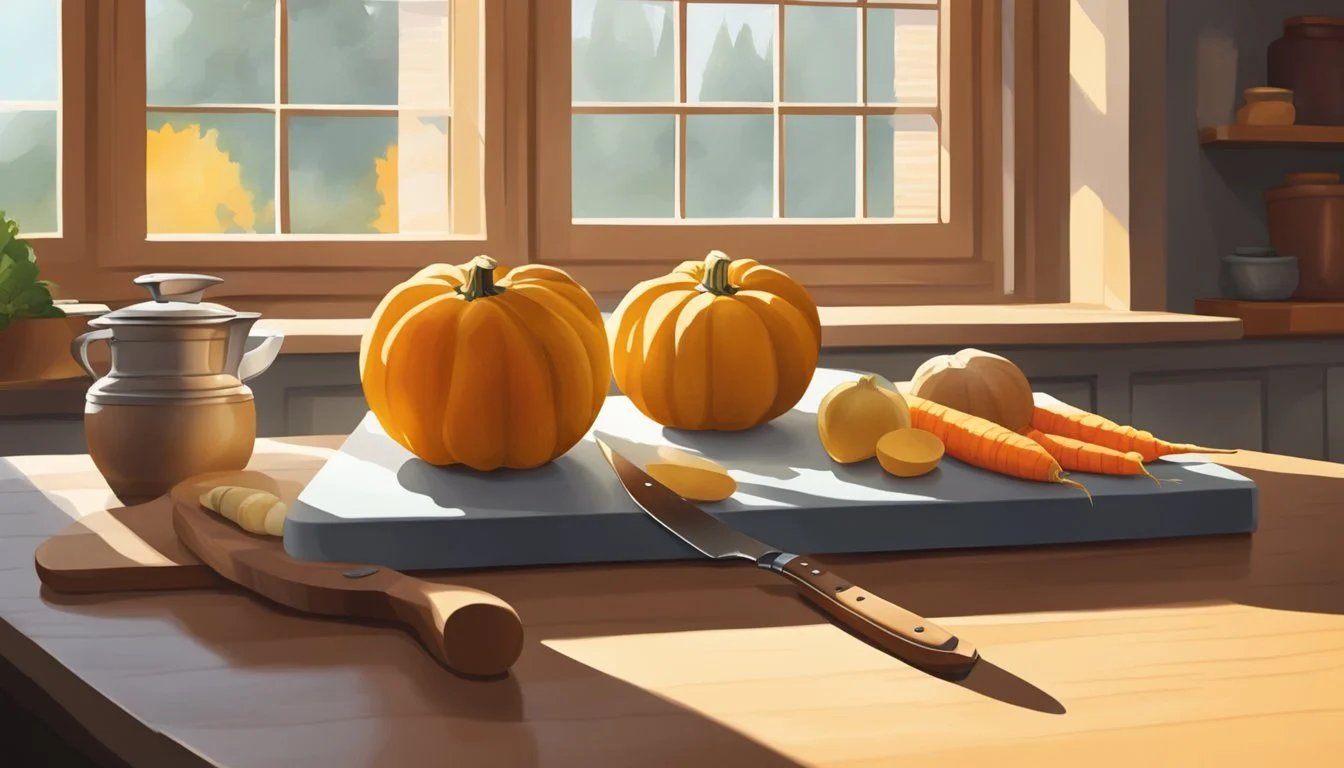Iowa Seasonal Fruit & Vegetables in February
Your Fresh Produce Guide
This Article is Part of our Iowa Seasonal Fruit & Veg Calendar
February in Iowa brings with it a quieter time for local produce, as fields rest under blankets of snow and farmers prepare for the upcoming growing season. The state's robust agricultural output takes a pause, but this does not mean that fresh produce is entirely off the menu. During these colder months, Iowans turn to cold storage crops and the last of the hearty winter vegetables. They also benefit from the citrus fruits at their peak, vibrant additions to the more limited winter palette.
At this time of year, consumers find that Iowa's markets may have less variety, but the quality of available produce, such as potatoes, onions, (What wine goes well with onions?) and carrots (how long do carrots last?), remains high. These storage crops, harvested in the fall, are engineered by nature to keep well through the colder months when the fields are barren. Citrus fruits, though not native to the chilly Midwest, are in abundant supply due to their peak seasons in warmer climates, adding a burst of flavor and nutrition to the Iowan winter diet.
While the fields lay dormant, greenhouses and indoor farming operations might offer a selection of greens such as lettuces and herbs, showcasing the ingenuity of local agriculture. These off-season farming techniques ensure that fresh, usually summery flavors are still accessible, although in limited quantities. February is a month for Iowans to celebrate the hardiness of winter produce and enjoy the tangy sweetness of seasonal citrus even amidst the coldest time of the year.
Seasonal Overview
In Iowa, February marks the heart of winter, challenging local agriculture with cold weather while also offering a unique variety of seasonal food. Consumers and growers alike adapt to the rhythm of the seasons to make the most of the local produce available.
Significance of Seasonal Eating
Seasonal eating in Iowa is rooted in consuming fruits and vegetables that are naturally harvested at their peak in the current month. This practice supports local agriculture, reduces the carbon footprint associated with long-distance food transport, and ensures the freshest and most flavorful produce. In February, the emphasis on seasonal food draws attention to the importance of adapting diets to include storage crops and those that can withstand the cold climate.
February's Weather Impact on Crops
February's weather in Iowa, characterized by its cold temperatures and frost, significantly affects which crops are available. Vegetables that thrive in such conditions tend to be hearty winter varieties, often stored from fall harvests or capable of surviving in the cold ground. The frost can result in sweeter flavors in some root vegetables, enhancing their taste profile. The availability of fruit in February is limited due to the harsh weather conditions, yet certain cold-storage fruits remain accessible during this winter month.
Fruits typically available from cold storage in February:
Apples
Pears
Commonly available vegetables in February, either from storage or winter-hardy varieties:
Carrots
Potatoes
Cabbage
Brussels sprouts (how long do brussels sprouts last?)
Onions
Consumers frequently rely on these stored or winter-resistant varieties for their seasonal food needs during the cold Iowa winter.
Fruits Available
In Iowa during February, residents can indulge in a variety of citrus fruits and take advantage of still-available storage fruits that retain their quality from previous harvests.
Citrus Fruits Variety
Citrus fruits flourish in winter months, and Iowa's markets are typically stocked with a diverse assortment.
Blood Oranges: Recognizable for their deep red flesh, blood oranges offer a berry-like taste alongside typical citrus flavors.
Lemons: Including the classic Eureka lemons used for their tart, zesty flavor ideal for both culinary and household uses.
Oranges: Conventional navel oranges are abundantly available, known for their sweetness and easy-to-peel nature.
Grapefruits: Varieties like the ruby grapefruit can be found, prized for their juicy, slightly tart taste.
Storage Fruits
Fruits that were harvested in the fall and stored properly maintain their freshness through the winter.
Apples: Various varieties that store well, such as Fuji or Honeycrisp, remain crisp and sweet.
Pears: Storage-friendly varieties like Bosc or D'Anjou pears are available, offering a soft, buttery texture when ripe.
By February, these hand-picked fruits provide not only vibrant flavors but also essential vitamins and nutrients beneficial for health during the colder months.
Vegetables in Season
In February, Iowa's cold climate dictates that many vegetables remain out of season; however, certain resilient varieties continue to be available. Residents of Iowa can still enjoy a selection of cruciferous vegetables, root vegetables, and leafy greens during this month, grown in the state or stored from the autumn harvest.
Cruciferous Vegetables
Cruciferous vegetables thrive in the cooler temperatures of Iowa's winters. Broccoli and Brussels sprouts, both cold-tolerant, are often available fresh during this time. Cauliflower may also be found, though its availability is more limited as it is less frost-resistant compared to its cruciferous counterparts.
Kale: Hardy and nutritious, kale can often withstand the cold.
Cabbage: A staple in winter dishes, cabbage stores well and remains a viable option.
Root Vegetables
Root vegetables, known for their ability to be stored for long periods after the fall harvest, are a staple in February. Their robust nature allows them to retain freshness and flavor even through the chill.
Carrots: Sweet and crunchy, they maintain quality well into the winter.
Beets (how long do beets last?): Rich in color and nutrients, they're a flavorful choice.
Turnips and parsnips: Offer a slightly peppery kick and are versatile for cooking.
Leeks: Provide a milder onion-like flavor and hold up well in cooler storage.
Leafy Greens
Even in the depths of winter, some hardy greens are typically available to those seeking fresh, nutrient-rich options.
Collards: These are known for their cold-hardiness and can often be harvested into the winter months.
Spinach: Although less cold-tolerant than collards, spinach can still be found, often grown in protected environments like greenhouses.
Herbs and Other Produce
While fruits and vegetables are often the focus of February harvests, the herbs and other produce categories should not be overlooked. They present flavors and health benefits, essential to the kitchen repertoire during the winter months.
Alliums and More
Onions: Iowa gardens yield storage onions that are ideal for use in a variety of dishes. In February, they continue to be available from storage, offering strong flavor and versatility. Onions are a staple in many recipes, providing a base for soups, stews, and sautés.
Garlic (What wine goes well with garlic?): Another allium in the spotlight is garlic. February is not the time for garlic planting, but rather for using the supplies stored from the previous year's harvest. Garlic's potent flavor enhances a multitude of culinary creations, and it is also acknowledged for its health-promoting properties.
Mushrooms: Although not typically grown outdoors, mushrooms are a part of Iowa's indoor agricultural produce. Various varieties, such as button mushrooms, shiitake, or oyster mushrooms, can be found in the markets. Mushrooms contribute earthy flavors and are a good source of protein and fiber, making them a praised ingredient among vegetarians and meat-eaters alike.
Herbs: The cold February weather may limit outdoor herb growth in Iowa, but many herbs thrive indoors year-round. Herbs like rosemary, thyme, and parsley can be grown on a sunny windowsill, providing fresh flavors to enliven winter meals.
Preparation and Recipes
In the cold month of February in Iowa, utilizing in-season produce can elevate dishes with a burst of freshness. Seasonal fruits and vegetables like citrus, root vegetables, and leafy greens can be transformed into vibrant main dishes, comforting soups and stews, and crisp salads and sides.
Main Dishes
Seasonal vegetables like carrots and turnips can be roasted to bring out their sweetness and served as a hearty accompaniment to proteins. Citrus fruits, when segmented or zested, add a refreshing note to savory dishes. One might consider a roasted root vegetable hash or a citrus-glazed chicken.
Recipe Suggestion: Orange and Honey Glazed Carrots
Ingredients: Carrots, Fresh Orange Juice, Honey, Olive Oil, Salt, Pepper
Instructions: Glaze carrots in a mixture of orange juice and honey, roast until tender.
Soups and Stews
Root vegetables and leafy greens form the foundation for many warming soups and stews. They can be pureed into smooth, creamy soups or left chunky for texture. Adding spices can complement the sweetness of the vegetables.
Recipe Suggestion: Turnip and Greens Soup
Ingredients: Turnips, Leafy Greens, Vegetable Stock, Onion, Garlic, Olive Oil, Cream, Salt, Pepper
Instructions: Sauté onion and garlic, add diced turnips, cook until softened, add greens and stock, simmer, blend until smooth if desired, stir in cream, season.
Salads and Sides
For salads and sides, fresh greens and citrus combine to create dishes bursting with flavor and nutrition. A simple vinaigrette can be made using citrus juice, and fruits can be added to salads for a sweet and tart component.
Recipe Suggestion: Citrus and Beet Salad
Ingredients: Mixed Greens, Beetroot, Orange Segments, Walnuts, Feta Cheese, Olive Oil, Balsamic Vinegar (how long does balsamic vinegar last?), Salt, Pepper
Instructions: Combine greens, roasted beets, and orange segments, top with walnuts and feta, dress with a simple balsamic and olive oil vinaigrette, season.
Health Benefits
Consuming Iowa's seasonal produce in February not only supports local agriculture but also provides essential nutrients that can enhance one's health. These fruits and vegetables, harvested at the peak of their freshness, are a rich source of fiber, vitamins, and minerals.
Nutritional Value
Fruits like pears, which are among the popular seasonal produce, offer a good amount of fiber which aids in digestion and helps maintain a healthy weight. They are also loaded with vitamins such as vitamin C, which supports immune function, and vitamin K, essential for blood clotting.
Seasonal vegetables available in Iowa, such as brussels sprouts and kale, are nutrition powerhouses. Both are high in vitamin C and vitamin K, and they also provide vitamins A and B, important for eye health and energy production, respectively. Moreover, these vegetables are rich in minerals like potassium, which is necessary for heart health, and calcium, crucial for maintaining strong bones.
Iowa's winter produce ensures a diet diverse in:
Fiber: Essential for good digestive health.
Vitamins: Including vitamin A (vision health), vitamin C (immune system), vitamin K (bone health).
Minerals: Like calcium (bone strength) and potassium (heart health).
Emphasizing these nutrients through seasonal consumption can significantly contribute to overall well-being.
Supporting Local Farmers
In Iowa, supporting local farmers is crucial, especially considering the state's diverse agricultural output. By engaging with initiatives like Community Supported Agriculture (CSA), residents directly contribute to the local economy and gain access to a wide variety of fresh, seasonal produce.
Community Supported Agriculture
Community Supported Agriculture (CSA) programs are a partnership where consumers invest in a local farm's growing season and, in return, receive a portion of the farm's harvest. This model benefits farmers by providing them with early-season capital, which can help cover initial costs such as seeds and equipment. For consumers, CSAs offer a closer connection to their food source and the satisfaction of supporting local agriculture.
Local farmers in Iowa may offer CSAs that include a range of crops, providing fresh options for monthly seasonal produce guides. Through CSAs, consumers can learn what is seasonal each month and often receive guidance on how to prepare less familiar items.
The Iowa Department of Agriculture and Land Stewardship (IDLs) encourages participation in local CSAs and often provides resources to help residents find and choose CSA options that suit their needs.
By joining a CSA, individuals can ensure they are getting the most from their local farmers and their state's agricultural offerings, while also experiencing the pleasures of fresh, homegrown fruits and vegetables.
Food Preservation Tips
Preserving the quality and freshness of fruits and vegetables is crucial, especially during months with fewer harvests. Proper storage can ensure that consumers enjoy the flavors and nutritional benefits of produce even when it's out of season.
Storing for Freshness
Vegetables: To maximize longevity, most vegetables should be kept in a refrigerator's crisper drawer. Here, they're afforded a more humid environment which helps maintain their crispness and prevents wilting. For example, root vegetables like carrots and beets can last several weeks when stored properly in a cool, humid, and dark place, such as a cellar or a refrigerator.
Leafy greens: These should be rinsed and stored in airtight containers with paper towels to absorb excess moisture.
Root vegetables: Store them in a cool, dark place; if refrigerated, place in perforated plastic bags.
Winter squash: Should be kept at room temperature, away from direct sunlight, and can last for a month or more.
Fruit: Apples, which are often still in season in Iowa during February, should be stored in a cool cellar or the crisper drawer to extend their freshness. Some fruit emits ethylene gas, which can hasten the ripening and spoilage of nearby produce. Keep these items separate from ethylene-sensitive fruits and vegetables to avoid premature spoilage.
Apples: Store away from other produce to prevent them from speeding up the ripening process of sensitive fruits and vegetables.
Citrus fruits: Keep them in a cool, well-ventilated space, and they can last several weeks.
For preservation methods beyond refrigeration, consumers can consider freezing, dehydrating, canning, or pickling their produce based on the type and intended use. Each technique aids in extending the life and freshness of produce beyond its natural ripening process.
Conclusion
In Iowa, February presents a limited but quality selection of seasonal produce. While the winter climate restricts the variety of fresh produce available, consumers can still find hearty vegetables that thrive in cooler temperatures. The produce harvested during this time is often excellent for warm, nourishing dishes that are perfect for the season.
Key vegetables available are:
Brussels sprouts
Cabbage
Carrots
Cauliflower
Kale
These vegetables are not only resilient to the cold weather but also offer high nutritional value. They are versatile and can be incorporated into a wide range of recipes, from stews and soups to roasted dishes.
Iowa's local markets and farm stores focus on providing these seasonal offerings, ensuring that consumers have access to fresh, locally-grown produce even in the colder months. It is always prudent for individuals to check with farms or markets directly for the most current information regarding availability and exact harvest times, as these can vary due to weather and specific regional conditions.
By choosing local and seasonal produce in February, Iowans support their local economy and farming communities while also enjoying the health benefits of fresh, nutrient-rich vegetables. As the month progresses, the anticipation for spring's diverse bounty grows, but until then, there is still plenty of freshness to be found on Iowa's tables.










